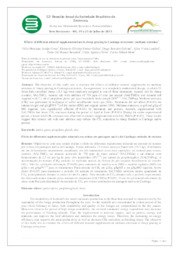Effects of different mineral supplementations in sheep grazing in Caatinga ecosystem: methane emission.
Effects of different mineral supplementations in sheep grazing in Caatinga ecosystem: methane emission.
Author(s): COSTA, H. H. A.; SALIBA, E. de O. S.; GALVANI, D. B.; LANDIM, A. V.; DEL BIANCO BENEDETI, P.; SILVA, F. A. e; MORA, C. M.
Summary: Abstract: The objective of this study was to evaluate the effects of different mineral supplements on methane emission of sheep grazing in Caatinga ecosystem. An experiment in a completely randomized design, in which 15 Santa Inês crossbred sheep (19.3 kg) were randomly assigned to one of three treatments: mineral salt for sheep (control; SALTMC), mineral salt with addition of 750 ppm of zinc per animal (SALTMZn) and mineral salt supplied with 2.5 ml of propylene glycol per kg of metabolic body weight (BW0.75; SALTMPeg). Methane emission (CH4) was performed by technique of sulfur hexafluoride tracer gas (SF6). Treatments did not affect (P>0.05) the intakes (in g/d and g/kgBW0.75) of dry matter (DM) and organic matter (OM). Methane emission, in g/d and g/kg of MO ingested, was significantly affected (P<0.05) by treatments and periods. Animals supplemented with SALTMZn had lower CH4 emission during the period of April to June (P<0.05). During the entire experimental period, a lower total CH4 emission was observed in animals supplemented with SALTMZn (P<0.05). These results suggest that mineral salt with zinc addition may reduce the CH4 emissions in sheep finished in Caatinga native pasture. [Efeito de diferentes suplementações minerais em ovinos em pastagem nativa da Caatinga: emissão de metano]. Resumo: Objetivou-se com esse estudo avaliar o efeito de diferentes suplementos minerais na emissão de metano por ovinos em pastagem nativa da Caatinga. Foram utilizados 15 ovinos mestiços Santa Inês (19,3 kg), distribuídos em um delineamento inteiramente casualisado, em três tratamentos com cinco repetições: sal mineral para ovinos, controle (SALTMC), sal mineral acrescido de 750 ppm de zinco anima-1 (SALTMZn) e sal mineral com fornecimento de 2,5 ml por kg de peso vivo metabólico (PV0,75) por animal de propilenoglicol (SALTMPeg). A determinação do metano (CH4) emitido foi realizada através da técnica do gás traçador hexafluoreto de enxofre (SF6). Não foi verificado diferenças (P>0,05) para consumos de matéria seca (MS) e matéria orgânica (MO) em g/dia e em g/kgPV0,75 para os tratamentos. Para emissão de CH4 em g/dia, g/kgMS e em g/kgMO ingerida, houve efeito (P<0,05) para tratamento e período. Os animais do tratamento SALTMZn emitiram menor quantidade de CH4, principalmente durante os meses de abril a junho. Para emissão de CH4 durante todo o período experimental, foi observado menor emissão pelos animais do tratamento SALTMZn (P<0,05). O uso do sal mineral adicionado de zinco contribui para diminuição da emissão de CH4 por ovinos terminados em pastagem nativa da Caatinga.
Publication year: 2015
Types of publication: Paper in annals and proceedings
Unit: Embrapa Goats & Sheep
Keywords: CH4, Caatinga, Emissão de gases, Emissão de metano, Grazing, Methane emission, Mineral nutrients, Mineral supplements, Native pasture, Nutriente mineral, Ovino, Pastagem nativa, Pastejo, Pasto nativo, Propilenoglicol, Propylene glycol, Sais minerais, Sheep, Suplemento alimentar, Suplemento mineral, Zinc, Zinco
Observation
Some of Embrapa's publications are published as ePub files. To read them, use or download one of the following free software options to your computer or mobile device. Android: Google Play Books; IOS: iBooks; Windows and Linux: Calibre.
Access other publications
Access the Agricultural Research Database (BDPA) to consult Embrapa's full library collection and records.
Visit Embrapa Bookstore to purchase books and other publications sold by Embrapa.

